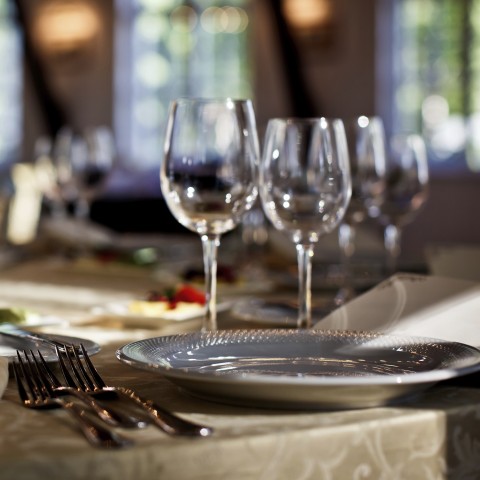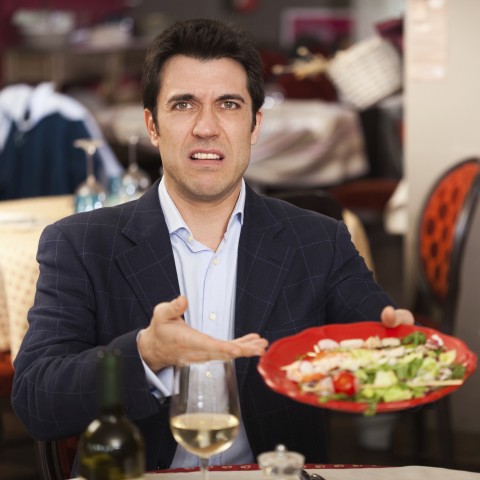
Even body language works well when ordering food in Vietnam. Whether it’s a food cart, a street food shop, or a fancy restaurant, basic body language can help you communicate with the seller.
Learning how to speak properly at a restaurant in Vietnam, on the other hand, requires a little bit more effort. You may want to know some useful phrases to use as well as common etiquette in Vietnamese restaurants, especially when you’re not sure what and how to order or they don’t speak English.
Vietnam, fortunately, is an amazing country in terms of food and cooking styles. There are countless types of food throughout the country, and therefore, restaurant types also vary accordingly. In this article, I’m going to introduce to you different Vietnamese restaurant styles, useful vocabulary, numerous Vietnamese phrases to use at a restaurant, and other things you will definitely use as travel guides in Vietnam.
 Table of Contents
Table of Contents
- Các kiểu quán ăn ở Việt Nam (Different Vietnamese restaurant styles)
- Từ vựng về nhà hàng (Restaurant vocabulary)
- Before Dining (Trước khi ăn)
- During Dining (Trong khi ăn)
- After Dining (Sau khi ăn)
- Conclusion
1. Các kiểu quán ăn ở Việt Nam (Different Vietnamese restaurant styles)
A- Đồ ăn đường phố (Street food)
Street food is everywhere in Vietnam, such as Hoi An, Da Nang, Hue, Hochiminh City, Hanoi or Hai Phong. Since street food is super affordable, street food shops, therefore, don’t have a specific style because it all depends on the type of food or the culture of the owner’s family. Lots of street food stalls selling heirloom foods passed down from their grandparents. Hence, it creates a very unique style for each dish that they serve.
Examples (Ví dụ) :
- Hải Phòng rất nổi tiếng với món bánh mì que (Hai Phong is very famous for its breadstick)
- Phở là một món ăn đường phố nổi tiếng ở Việt Nam (Pho is famous street food in Vietnam)
- Mì Quảng là món ăn đặc sản đặc trưng của Đà Nẵng (Quang noodle is a typical specialty dish of Da Nang)
Despite the variety and style, street food is very affordable and can be easily found everywhere. A dish can often cost only 5000 VND, which is less than a dollar. As long as you have from $1 to $3 on hand, you can have a full meal when exploring street food in Vietnam, and it’s one of the things that make Vietnam special.
B- Quán ăn vỉa hè (Sidewalk Eatery)
Food shops on the sidewalk are quite similar to street food shops or stalls in terms of price and style. The main difference is that you have a table and a chair to sit on and it’s very common for most locals since it’s suitable for the living costs.
While street food shops usually serve 1 dish only, food shops on the sidewalk have more choices for you to go with. For example, if you go to a snail shop, there will be plenty of different dishes.
Examples (Ví dụ) :
- Các quán ốc vỉa hè có rất nhiều trong Sài Gòn (There are many sidewalk snail shops in Saigon)
- Đi ăn vặt vỉa hè là một thú vui của người Việt Nam (Snacking on the sidewalk is a hobby of Vietnamese people)
C- Quán ăn/tiệm ăn bình dân (Affordable food shop)
An affordable food shop is a little bit more upscale than a food shop on the sidewalk because there might be staff members to serve you and the service will be better also. Here you can also find more kinds of food from noodles to rice, from chicken to seafood. Many shops serve both Vietnamese food and Western food cooked in Vietnamese style to suit Vietnamese people’s tastes. The price is around $3 – $5, and the portion is also bigger than street food. This kind of shop is suitable for families, a group of friends, or coworkers, and it’s usually busy on weekends. Most of them don’t require a reservation, and you can come anytime.
D- Nhà hàng (Restaurant)
A restaurant is the fanciest type among the four, and it’s usually suitable when you go out on a date, celebrate anniversaries, or organize company events.

In Vietnam, Chinese restaurants, Japanese restaurants, Thai restaurants, and Korean restaurants are probably the most common ones because they’re close to Vietnamese cuisine. In contrast, Western fast food is served in restaurants in Vietnam, but it doesn’t seem to attract Vietnamese people a lot since it contains more fat compared to Vietnamese food, and it’s also more expensive.
Restaurants often don’t require reservations on weekdays but might do on weekends and public holidays due to the high demands. A dish usually costs $5-10, not including 10% tax, but there is no service charge and you can give waiters or waitresses whatever you wish.
2. Từ vựng về nhà hàng (Restaurant vocabulary)
Learning the Vietnamese language is similar to learning Lao or Thai because of the way we put the words together in a sentence.
Before moving to common restaurant phrases, here are some useful vocabulary that you will definitely use at a restaurant in Vietnam.
A- Danh từ (Noun)
- Đồ ăn (Food)
- Đồ uống (Drink)
- Đồ nhậu (Snack for drinking)
- Đồ ăn kèm (Side dish)
- Rau sống (Raw vegetables)
- Món khai vị (Appetizer)
- Món chính (Main dish)
- Món tráng miệng (Dessert)
- Thực đơn (Menu)
- Hoá đơn (Bill)
- Bàn (Table)
- Ghế (Chair)
- Đặt bàn (Reservation)
- Nhân viên phục vụ (Waiter/waitress)
- Khách (Customer)
B- Động từ (Verb)
- Đặt bàn (To make a reservation)
- Đi ăn (To go eating)
- Gọi món (To order)
- Ăn (To eat)
- Uống (To drink)
- Phục vụ (To serve)
- Dọn bàn (To clean the table)
- Thanh toán (To pay)
- Chờ (To wait)
C- Tính từ (adjective)
- Ngon (Good/Delicious)
- Không ngon (Not good/bad)
- Dở tệ (Terrible)
- Nhạt (Bland)
- Mặn (Salty)
- Nhiều dầu (Oily/greasy)
- Khô (Dry)
- Đặc (Thick)
- Loãng (Thin)
- Nhanh (Quick,fast)
- Chậm (Slow)
- Ồn ào (Noisy)
- Đông đúc (Crowded)
- Vắng vẻ/yên tĩnh (Empty/Quiet)
3. Before Dining (Trước khi ăn)
As mentioned above, you don’t need to make a reservation before going to a restaurant in Vietnam unless it’s on weekends or public holidays.
In case you need to make a phone call for a reservation, here is one of the basic Vietnamese phrases to say:
| Cấutrúc (Structure) | Cho (Let/allow) | Chủ ngữ (Subject) | đặt bàn (make a reservation/book) | thời gian (time) |
| Vídụ (Example) | Cho (Let/allow) | tôi (me) | đặt bàn (to book/to reserve a table) | lúc 8h tối nay (at 8PM today) |
Ví dụ:
- Cho tôi đặt bàn lúc 11h trưa nay (I would like to book a table at 11AM today)
- Cho anh đặt bàn ngày mai (I would like to book a table tomorrow)
Besides, there will be some extra questions to make it more specific, here’s how you can respond to those:
- Anh/chị đặt bàn mấy người (How many people will there be?)
Tôi đặt bàn 2 người (I’m booking for 2 people)
- Anh chị có yêu cầu gì đặc biệt không (Do you have any special requests?)
Tôi muốn + yêu cầu (I’d like + request)
Ví dụ: Tôi muốn bàn gần cửa sổ (I’d like a table near the windows.)
- Anh chị có muốn gọi món trước không (Would you like to order in advance?)
Không/Có (No/Yes)
- Anh chị vui lòng gửi xe ở (Please park your vehicle at …) – If the restaurant doesn’t have a parking lot
Anh chị vui lòng tới đúng giờ. Nhà hàng hỗ trợ giữ bàn trong 30 phút (Please arrive on time. We could keep the table for 30 minutes.)
For some reason, you have to cancel the plan. Here’s how you can do so:
- Tôi muốn huỷ đặt bàn hôm nay (I’d like to cancel my reservation today)
Bàn đặt của tôi dưới tên Linh (My reservation is under Linh’s name)
4. During Dining (Trong khi ăn)
This is the main part where you will communicate with the staff directly at the restaurant, from getting their attention to giving feedback after the meal. The sentence structures that I’m going to list down right now are basically the simplest to practice. Let’s get right into them.
A- Getting the waiter’s attention

To call someone coming to your table, the easiest way is to say:
- Em ơi/Anh ơi/Chị ơi
Calling the waiter is not considered rude in Vietnam. Is it on the other hand quite common and easy to get their attention. In case you feel like the restaurant ambiance is a little bit private or quiet, there are several other ways such as:
- Vẫy tay (Wave hand)
- Bấm chuông (Push the bell)
- Giao tiếp bằng mắt (Eye contact)
B- Asking about the menu
- Cho tôi mượn menu (May I have the menu please)
- Ở đây có món gì? (What do you have here?) – In case the food shop doesn’t have a menu
- Em có thể giới thiệu món nào ngon được không? (Can you recommend a few good dishes/ your signature?)
C- Asking about specific things
When coming to a new place that you haven’t been to before, there might be something that you find confused or just simply want to make sure you’re not allergic to. These are a few questions you can ask:
- Món này có cay không? (Is it spicy?)
- Món này cho 2 người có đủ không em? (Is it good for 2 people?)
- Món này không bỏ hành được không? Tôi không ăn được hành (Can you not put onion in this dish? I don’t eat onions)
- Em ơi chị có bàn đặt tên Linh, bạn chị đến chưa? (I have a table under “Linh” name, has my friend come yet?)

D- Ordering
Using the same structure when making a reservation, here is what you can use for ordering food in Vietnam.
| Cấu trúc (Structure) | Cho (Give) | Chủ ngữ (Subject) | số lượng (quantity) | món ăn (dish) |
| Ví dụ (Example) | Cho (Give) | tôi (me) | 2 (two) | phở bò (beef noodle) |
Remember that in this case, “cho” means “give” instead of “allow” or “let” as the one mentioned above although it sounds the same.
Ví dụ:
- Cho chị 2 suất bún chả (Give me 2 portions of bún chả please)
- Cho anh 1 pizza bò (Give me 1 beef pizza please)
E- Asking for utensils
- Cho tôi 1 đôi đũa (Give me a pair of chopsticks please)
- Cho tôi 1 cái thìa (Give me a spoon please)
F- Asking where the bathroom is
- Em ơi, toilet ở đâu? (Where is the bathroom/restroom?)
- Em ơi, chỗ rửa tay ở đâu? (Where can I wash my hands?)
G- Making complaints

- Em ơi, món này mặn quá (This dish is too salty)
- Em ơi, món này không đúng yêu cầu của chị (This dish is not what/ how I wanted it to be)
- Em ơi, chị không gọi món này (I didn’t order this)
- Món này hơi nhạt và nguội (This dish is a bit bland and cold)
- Thịt bò của chị hơi tái, chị muốn chín hơn một chút (My beef is a bit too raw, I want it to be a little more cooked)
H- Giving feedback
At some high-class restaurants, there will be someone coming to ask for feedback after the meal. What they might say is:
- Anh chị thấy đồ ăn hôm nay thế nào? (How do you like the food today?)
And this is how you can say:
- Đồ ăn rất ngon, cảm ơn em (The food is really good, thank you)
- Đồ ăn rất vừa miệng (The food is very tasty)
- Phục vụ hôm nay hơi chậm nhưng đồ ăn rất ngon (Service is a bit slow today but the food is delicious)
5. After Dining (Sau khi ăn)
A- Asking for the bill
- Em ơi, tính tiền cho chị/anh (Please charge me)
- Em ơi, thanh toán cho chị/anh (May I pay please)
B- Payment method
There are options for you to choose whether to pay by cash, credit card or transfer the money directly to the owner. Here is what they will ask:
- Anh chị thanh toán bằng thẻ hay bằng tiền mặt? (Would you like to pay by card or cash?)
And you can say:
- Tôi trả thẻ (I’d like to pay by card)
- Tôi trả tiền (I’d like to pay by cash)
- Tôi muốn chuyển khoản (I’d like to transfer money)
C- Asking for a take away
In case you couldn’t finish the meal and still have a lot on the table, you can ask the waiter to pack the food for you by saying:
- Em ơi, gói giúp chị cái này mang về với (Help me pack this for takeaway, please)
- Em ơi, chị muốn đặt 1 phần mang về (I’d like to order a takeaway)
D- Tipping etiquette
Tipping is not quite common in Vietnam yet because the staff members get paid monthly with or without your tip. Tipping is sometimes even awkward when the restaurant culture doesn’t require it or the staff members are shy to take it.
At regular food shops, the most common way to thank the owner or the staff members is to leave some change from the bill. If you really enjoyed the meal and want to show some appreciation to the waiter or waitress who has done their job well, you can leave some tip on the table before you leave. In that way, it will be comfortable for both. Also, if you want to directly give it to the waiter/waitress, here are several Vietnamese phrases you can use:
- Em có thể giữ lại tiền thừa (You can keep the change)
- Còn lại là của em (The remaining is yours)
6. Conclusion
Exploring the cuisine is one of the most interesting things when traveling to Vietnam or any country. Knowing some basic restaurant phrases to use at the right time is gonna be extremely helpful especially when you want to learn more about the cultures through communicating with locals.
At VietnamesePod101, we will provide you with more basic Vietnamese phrases, vocabulary lists, flashcards and audio files to help you be more confident when learning Vietnamese. Get access to your free lifetime account right now and get your real lessons by real teachers.
Speaking of which, I suddenly feel hungry. Maybe I should go get something to eat right now. I hope you enjoyed reading and see you in the next one.










